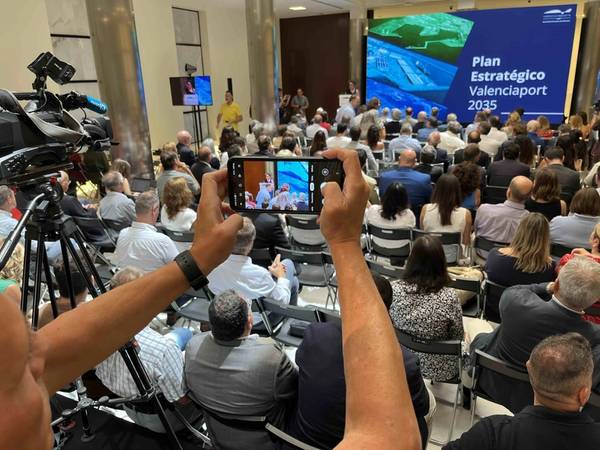
The Port Authority of Valencia (PAV) presented its Strategic Plan at the Clock Building of the Port of Valencia, outlining a vision and series of projects with a clear target year of 2035.
This is a ten-year plan designed to consolidate Valenciaport as a generator of wealth and quality employment, while also acting as a driver of investment and transformation in the port and logistics ecosystem. Its mission is to deliver the best possible service to the business sector.
By 2035, Valenciaport aspires to handle up to 45% of Spain’s loaded container traffic for imports and exports. Rail transport will play a critical role in reaching this goal, with the aim of managing nearly one in every five containers (17%) entering or leaving the ports of Valencia and Sagunto by rail.
However, road transport will continue to play a fundamental role. Valenciaport will remain firmly committed to road haulage as an essential link in the logistics chain.
It is estimated that over the next decade, terminals operated by the PAV will generate around 80,000 jobs (up from 50,000 at present), and will mobilize USD$46.5 million (€40 million) through various digitalization projects to position the port at the forefront of global logistics. All of this aligns with the Strategic Framework of the Spanish Port System and the United Nations Sustainable Development Goals (SDGs).
The Plan sets out a series of management indicators to ensure economic sustainability through financial discipline and expenditure control, enabling growth that responds to demand and the needs of Spain’s export sector.
Objectives and Projects of the Strategic Plan
One of the Plan’s key objectives is to optimize port and logistics infrastructure to meet the evolving demands of global trade. To that end, it will promote flagship projects such as the new North Terminal, improved rail access to the ports of Valencia and Sagunto, and the full development of strategic logistics zones such as the ZAL and Fuente de San Luis.
Decarbonization, resilience and the fight against climate change are central pillars of the Plan. Valenciaport is committed to its Net Zero Emissions Plan, through the adoption of renewable energy, shore power supply (OPS), alternative fuels, and carbon offsetting tools. It will also promote the development of green corridors, climate adaptation of the port environment, and projects linked to the Hydrogen Valley in Sagunto.
The Plan also recognizes the vital role of human capital and innovation in shaping Valenciaport’s future. It encourages an open innovation ecosystem, the development of a digital twin of the port, the full digitalisation of operations, and the technological transformation of management systems. In parallel, it seeks to improve port-city integration in Valencia, Sagunto and Gandia, foster citizen-facing spaces, and promote inclusive employment, equality and dual training programs.
To meet these objectives, the document—presented first to PAV staff and later to social representatives and the Port Community, who actively contributed to its creation—sets out 20 strategic projects and over 150 concrete initiatives.
These projects are structured around five strategic pillars. The first includes actions deemed to energize the system (infrastructure optimization, synergies with key clients, sustainable passenger offerings, and targeted measures in Sagunto and Gandia).
The second focuses on environmental actions, including the Net Zero Emissions Plan and risk management, resilience, and climate adaptation. The third addresses Valenciaport’s innovation and digital leadership; the fourth, the port’s role in generating quality and fostering city-port relations; and the fifth, the port’s aim to be a model of good governance and economic self-sufficiency.
A Participatory and Inclusive Plan
The Plan was led and drafted by Dutch consultancy MBTS and the Valenciaport Foundation. It was developed with the collaboration of the Port Community and the main socioeconomic stakeholders involved in the logistics and port activity of Valencia, Sagunto and Gandia—across the Valencian Community and its broader hinterland.
More than 200 stakeholders (including companies, institutions, logistics operators, public administrations and associations) actively participated in the design process, contributing strategic and operational insights.
The Plan’s development involved a thorough analysis of the international context, maritime trade trends, and major challenges facing the global port system, such as digitalization, energy transition and logistics chain congestion. This diagnosis was cross-referenced with economic, environmental, technological and social data at national and European level. Benchmark models from leading ports were also studied to identify best practices adaptable to the Valencian context.
Throughout the drafting process, over 60 technical meetings, sectoral workshops and in-depth interviews were held—both internally and externally. These included sessions with technical and executive PAV staff, working groups with representatives of road and rail transport, public bodies, trade unions, universities and businesses. Specific meetings were also held with local authorities and social representatives from Valencia, Sagunto and Gandia to ensure strong city-port links.



